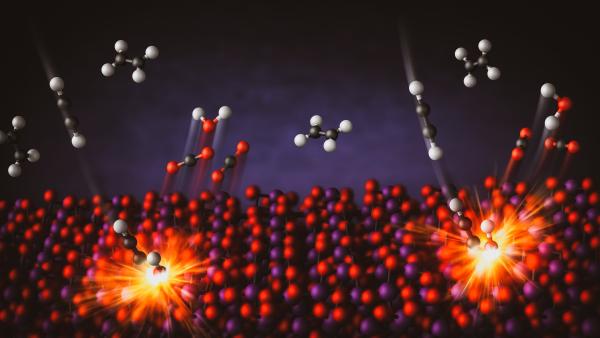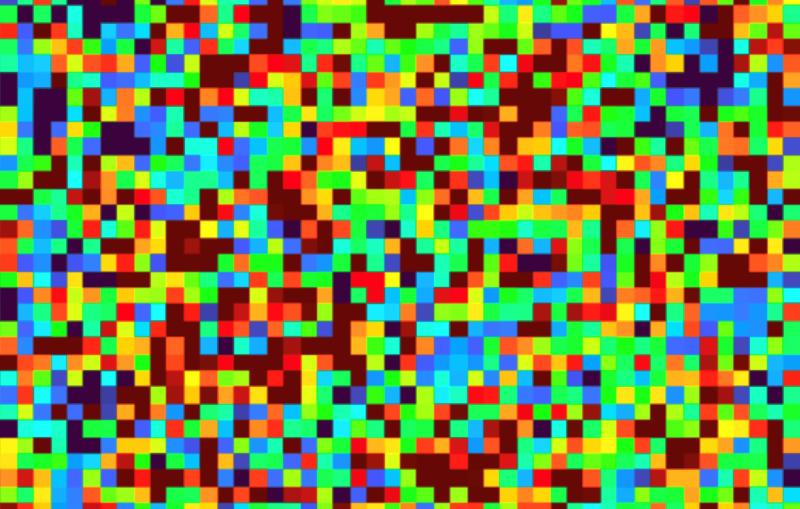Longstanding model fails to explain spin dynamics in 1D cuprates
In a recent study, the Hubbard model was unable to predict the behavior of a simplified, one-dimensional cuprate system. SLAC scientists say the model is unlikely to fully explain high-temperature superconductivity in 2D cuprates.

Superconductivity – the ability of some materials to conduct electricity with no energy loss – holds immense promise for new technologies from lossless power grids to advanced quantum devices. A recent publication in Physical Review Letters by researchers at the Stanford Institute for Materials and Energy Sciences (SIMES) at the Department of Energy’s SLAC National Accelerator Laboratory sheds light on an outstanding mystery in the study of superconductivity: high-temperature superconductivity in cuprates.
Doubling down on results from a previous SLAC study, the paper provides further evidence that the Hubbard model – the leading theory for describing strong correlations between electrons in quantum materials – fails to explain electron dynamics in cuprates, even in simplified, one-dimensional systems.
“Understanding what causes high-temperature superconductivity in cuprates is a decades-long problem, and we’re building on the work of many great scientists here at SLAC and Stanford,” said Jiarui Li, a SLAC postdoc and lead author of the study. “As a postdoc, I'm excited to continue pushing the frontiers of this research.”
Typically, superconductivity occurs at temperatures approaching absolute zero, -273 degrees Celsius or -459 degrees Fahrenheit. But certain copper-oxides, known as cuprates, maintain their superconductivity at temperatures reaching -138 degrees Celsius or -216.4 degrees Fahrenheit – still cold, but significantly warmer than absolute zero. Importantly, that’s also nearly a hundred degrees Fahrenheit warmer than the boiling point of liquid nitrogen, making superconducting cuprates practical for wider applications in technology.
An understanding of the mechanisms that make superconductivity possible at such relatively high temperatures could be key to developing future applications and to fabricating new materials that can superconduct at even higher temperatures, ideally closer to room temperature.
Scientists know that superconductivity occurs when electrons form pairs, called Cooper pairs, within a material. The formation of these pairs in metals, such as mercury and lead, is explained by a Nobel Prize-winning theory known as the BCS theory. But the electronic structure of cuprates is fundamentally different than metals and requires a different theory to explain how superconducting electrons form pairs.
Initially, scientists hoped that the Hubbard model, with its demonstrated ability to describe strong correlations between electrons, might be able to explain how high-temperature superconductivity works in cuprates. But this assumption was unproven, and experimental validation has proven challenging. The complexity of cuprate materials and the mathematical intricacies of the Hubbard model make it difficult to model the problem accurately with current computers and algorithms.
After 20 years of trying, scientists succeed in doping a 1D chain of cuprates
The chemically controlled chains reveal an ultrastrong attraction between electrons that may help cuprate superconductors carry electrical current with no loss at relatively high temperatures.

In 2021, SLAC researchers found a way to simplify the problem: examining cuprate behavior in one dimension rather than two. In a first, the team created a 1D chain of cuprate atoms doped with oxygen and used X-rays to study the behavior of holons – particle-like entities that represent an electron’s charge. Their analysis revealed that the attraction between neighboring electrons was ten times stronger than the Hubbard model predicted, suggesting an additional attractive force not captured in the Hubbard model.
Researchers realized that if such a force was at work, it would leave telltale fingerprints on another important property of electrons, known as spin. To approach the problem from another angle, they devised a new experiment that would give them insight into the behavior of pairs of spinons. Like holons, spinons are particle-like components that represent properties of an electron; where holons represent an electron’s charge, spinons represent an electron’s spin.
The team synthesized a 1D sample of doped cuprate chains at the Stanford Synchrotron Radiation Lightsource at SLAC, then examined it using resonant inelastic X-ray scattering at the Diamond Light Source in the U.K. and the National Synchrotron Light Source II at Brookhaven National Laboratory.
Once again, their analysis of the behavior of spinon pairs found that the Hubbard model did not accurately predict the behavior of electrons. However, when they added the same extra attractive force seen in the earlier experiment to their calculations, the data aligned more closely with their experimental observations.
Co-PIs of the studyOur work has shown that the Hubbard model is inadequate to fully account for cuprate physics, even in a simple 1D system."
Stanford Institute for Materials & Energy Sciences
Unconventional superconductivity, better batteries, and quantum states of matter – learn more about SIMES research.

“Our work has shown that the Hubbard model is inadequate to fully account for cuprate physics, even in a simple 1D system. If the model has already failed at the 1D level, we wouldn’t expect it to hold up within the more complex 2D system, where high-temperature superconductivity occurs in cuprates,” said Wei-Sheng Lee, a SLAC staff scientist, and Zhi-Xun Shen, a SLAC and Stanford professor, co-principal investigators of the study.
The question now is what mechanism gives rise to the additional attractive force. Thomas Devereaux, a SLAC and Stanford professor and SIMES investigator who supervised the theoretical part of this work, suspects that it is due to an attraction between electrons and vibrations, known as phonons, in the lattice structure holding the cuprate together. Further experimentation is needed to investigate this idea, Devereaux said.
This research is funded in part by the DOE Office of Science. The Stanford Synchrotron Radiation Lightsource at SLAC and the National Synchrotron Light Source II at Brookhaven National Laboratory are DOE Office of Science user facilities. Li received funding from SLAC’s Laboratory Directed Research and Development Program.
Citation: Jiarui Li et al., Physical Review Letters, 8 April 2025 (10.1103/PhysRevLett.134.146501)
For questions or comments, contact SLAC Strategic Communications & External Affairs at communications@slac.stanford.edu.
About SLAC
SLAC National Accelerator Laboratory explores how the universe works at the biggest, smallest and fastest scales and invents powerful tools used by researchers around the globe. As world leaders in ultrafast science and bold explorers of the physics of the universe, we forge new ground in understanding our origins and building a healthier and more sustainable future. Our discovery and innovation help develop new materials and chemical processes and open unprecedented views of the cosmos and life’s most delicate machinery. Building on more than 60 years of visionary research, we help shape the future by advancing areas such as quantum technology, scientific computing and the development of next-generation accelerators.
SLAC is operated by Stanford University for the U.S. Department of Energy’s Office of Science. The Office of Science is the single largest supporter of basic research in the physical sciences in the United States and is working to address some of the most pressing challenges of our time.





